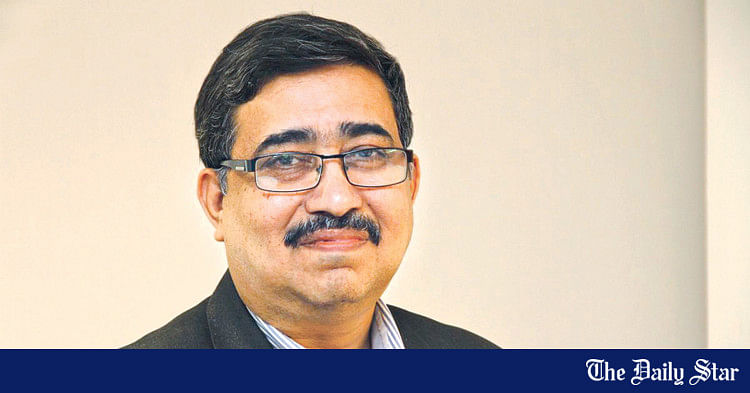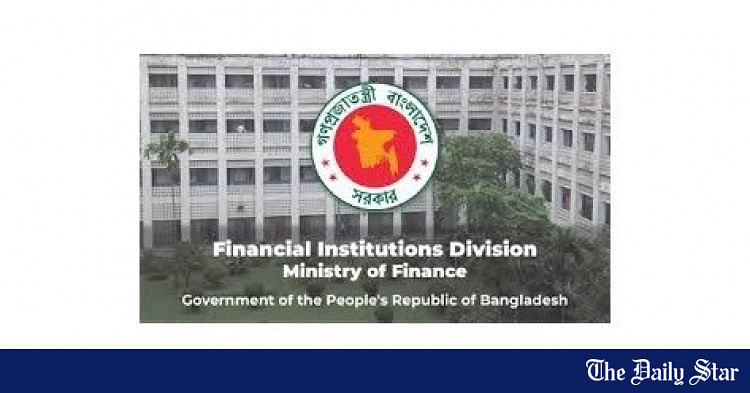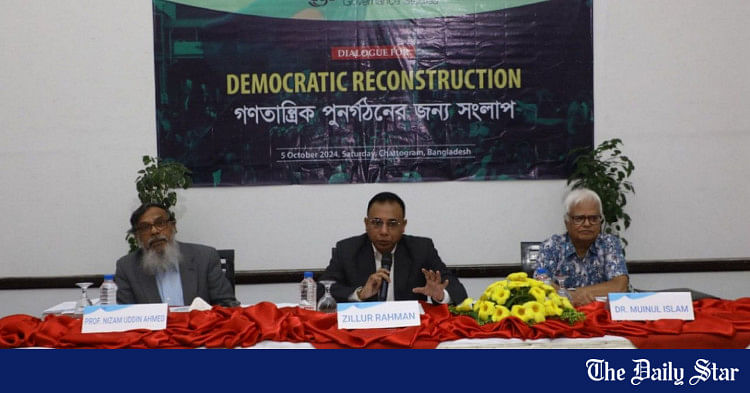Saif
Senior Member
- Joined
- Jan 24, 2024
- Messages
- 15,973
- Likes
- 8,002
- Nation

- Axis Group


Banking sector issues that the new governor should address
Good governance and adequate legal infrastructure—relevant laws, courts and impartial judges—need to be established.
Banking sector issues that the new governor should address
Good governance and adequate legal infrastructure need to be established

According to the Basel Accords, banks in Bangladesh need to maintain a minimum capital of 12.5 percent of risk-weighted assets. PHOTO: STAR
The economy of Bangladesh is heavily dependent on the banking sector as 86 percent of financial intermediation is conducted through banks. But this reliance has led to many problems for the economy in general and the banking sector in particular. Commercial banks typically provide small and short-term loans to a wide range of borrowers. By offering small loans to many borrowers, banks can build a well-diversified portfolio, which is crucial for minimising risk. A short-term loan with high turnover rate can be issued multiple times a year, increasing profit. However, instead of granting small loans, our banks tend to prioritise large loans, which they are able to do within the legal framework.
A large loan is defined as one that constitutes at least 10 percent of a bank's capital. A bank can sanction a loan of up to 25 percent of its capital to finance power sector projects. Within this framework, just four such borrowers could take up all of the bank's capital. If these borrowers default, the bank would become insolvent.
A bank can grant a borrower 15 percent of its capital as funded loans, which require immediate disbursement, and 20 percent as non-funded loans, which require delayed disbursement. As such, a borrower can get a loan of up to 35 percent of the bank's capital. In such a scenario, only three borrowers can deplete the bank's entire capital. In case of export financing, a borrower can receive a loan of up to 50 percent of the bank's capital, with the funded exposure not exceeding 15 percent of the bank's capital. In this case, only two borrowers could consume the bank's capital. When banks issue large loans, they fail to build a diversified investment portfolio, leading to an imbalance between risk and return.
The availability of large loans hinders the growth of our stock market. Banks are involved in indirect finance, where they collect funds from depositors and lend them to borrowers. Borrowing from banks is easier because borrowers are accountable to banks, not to the depositors. In contrast, stock markets are involved in direct finance where borrowers have to obtain funds directly from the suppliers of capital. Here, borrowing firms have to win over suppliers of funds through their performance, ultimately reflected in their share prices. In an efficient market, it is very difficult for less creditworthy borrowers to raise funds. However, due to our banking sector being plagued by ill-governance, less creditworthy borrowers—with political connections—can easily convince banks to grant loans.
When banks provide long-term loans from their short-term deposits, it imposes major risks on their depositors. Granting large loans goes against the basic principle of bank lending, as it creates maturity mismatch wherein depositors' claims to the bank mature earlier than banks' claims to borrowers. This can lead to liquidity problems, making it difficult for banks to honour customers' cheques. Large loans are also more likely to default. In contrast, small loans contribute significantly to the economy by reducing income inequality between the rich and the poor, and the default rate for small loans is low. Therefore, every bank should allocate a certain percentage of its funds for small loans.
Restrictions should be placed on single-borrower exposure and large loans from banks. As a result, large borrowers will turn to the stock market—and policymakers will be more diligent in developing this market from its precarious condition.
Bangladesh Bank (BB) regularly discloses non-performing loans (NPLs)—the latest reported amount is Tk 1,82,295 crore, compared to just Tk 22,481 crore in 2009. However, there is always doubt about the accuracy of its reported NPL figures. A true picture of distressed assets should include not only NPLs but also write-off loans, rescheduled loans, and loans stuck in courts. This would provide a more accurate assessment of the banking sector's asset quality. The NPL rate of 10.11 percent in 2023, as reported by BB, would increase to roughly 30 percent if all distressed assets were considered. In an attempt to reduce the ever-growing NPLs, the central bank has frequently changed loan classification rules, deviating from international standards. Despite these efforts, the usual growth of NPLs has not been curbed.
When a loan becomes non-performing, BB permits loan rescheduling where a loan is renewed or extended under circumstances that are beyond the control of the borrower. The rescheduling is allowed a maximum of three times, examining the causes for the loan's non-performance. The down payment for rescheduling ranges between 10 and 30 percent of the outstanding loan and the time limit never exceeds three years.
Despite the large number of banks in our country, many people are still outside the banking network. This is a contradiction. The rural poor are less interested in maintaining bank accounts, while the urban poor keep their money in semi-formal and informal repositories. So, should we reduce the number of banks through merger and acquisition?
For the past decade, loan rescheduling has been permitted by breaking existing rules. Moreover, in 2015, a loan restructuring facility was provided to 15 large borrowers with loans of Tk 500 crore and above, upon receiving a down payment of only 2 percent of the outstanding loan amount. The loan terms were extended to 10 years.
There are huge political repercussions when NPLs rise. While there is less fuss about write-off loans, a write-off loan represents the worst state of NPLs. The amount of write-off loans stood at Tk 51,560 crore in 2023, up from Tk 15,300 crore in 2009. BB also relaxed the rules for loan write-off. Earlier, to write a loan off, it needed to remain unpaid for five years, a 100-percent provision needed to be maintained, and a case was required to be filed against the borrower. Later, the unpaid period of an NPL was reduced from five to three years, allowing banks to quickly remove their worst loans from the balance sheet.
If BB wants to reduce NPLs, the nexus between business and politics must be broken so that politically connected individuals cannot intentionally default on loans. Good governance and adequate legal infrastructure—relevant laws, courts and impartial judges—need to be established. Borrowers have to be evaluated properly before loan sanctioning. Rules for loan rescheduling, restructuring and write-off must be strictly enforced.
According to the Basel Accords, banks in Bangladesh need to maintain a minimum capital of 12.5 percent of risk-weighted assets. Some banks consistently face capital deficit. Data shows that the capital shortfall of 10 private and public banks in the country reached Tk 39,655 crore in 2023.The capital base of our banks is also relatively low because of high NPLs and low reinvestment of profits. Bank owners are more interested in taking profits as dividends rather than reinvesting them as retained earnings.
There is also continuous capital flight from rural to urban areas. Data shows that even though rural areas supplied nearly 13 percent of deposits in 2010, they obtained only 8 percent of advances. The supply of deposits by rural people increased to 21 percent in 2023, but they received only 12 percent of advances—a capital flight of 9 percentage points to urban areas. The misuse of loans by wilful defaulters in urban areas poses a threat to rural depositors. To address this, more opportunities for using loans in rural areas should be created.
The overall expenditure management of banks is still not efficient. Data indicates that the expenditure-income ratio was around 99 percent on average between 1991 and 2000. It declined considerably to 73 percent in 2010 before increasing to 81 percent in 2023. These high ratios may be attributed to high staff salaries, provision for default loans, and high corporate tax rates. The elevated expenditure should be controlled as it is offset mainly against low pay to depositors.
Despite the large number of banks in our country, many people are still outside the banking network. This is a contradiction. The rural poor are less interested in maintaining bank accounts, while the urban poor keep their money in semi-formal and informal repositories. So, should we reduce the number of banks through merger and acquisition? Once the number of banks is reduced, it might be beneficial to increase their branches to spread services to remote areas and take advantage of economies of scale. These decisions should be made prudently.
Md Main Uddin, PhD is professor, Department of Banking and Insurance, University of Dhaka.
Good governance and adequate legal infrastructure need to be established
According to the Basel Accords, banks in Bangladesh need to maintain a minimum capital of 12.5 percent of risk-weighted assets. PHOTO: STAR
The economy of Bangladesh is heavily dependent on the banking sector as 86 percent of financial intermediation is conducted through banks. But this reliance has led to many problems for the economy in general and the banking sector in particular. Commercial banks typically provide small and short-term loans to a wide range of borrowers. By offering small loans to many borrowers, banks can build a well-diversified portfolio, which is crucial for minimising risk. A short-term loan with high turnover rate can be issued multiple times a year, increasing profit. However, instead of granting small loans, our banks tend to prioritise large loans, which they are able to do within the legal framework.
A large loan is defined as one that constitutes at least 10 percent of a bank's capital. A bank can sanction a loan of up to 25 percent of its capital to finance power sector projects. Within this framework, just four such borrowers could take up all of the bank's capital. If these borrowers default, the bank would become insolvent.
A bank can grant a borrower 15 percent of its capital as funded loans, which require immediate disbursement, and 20 percent as non-funded loans, which require delayed disbursement. As such, a borrower can get a loan of up to 35 percent of the bank's capital. In such a scenario, only three borrowers can deplete the bank's entire capital. In case of export financing, a borrower can receive a loan of up to 50 percent of the bank's capital, with the funded exposure not exceeding 15 percent of the bank's capital. In this case, only two borrowers could consume the bank's capital. When banks issue large loans, they fail to build a diversified investment portfolio, leading to an imbalance between risk and return.
The availability of large loans hinders the growth of our stock market. Banks are involved in indirect finance, where they collect funds from depositors and lend them to borrowers. Borrowing from banks is easier because borrowers are accountable to banks, not to the depositors. In contrast, stock markets are involved in direct finance where borrowers have to obtain funds directly from the suppliers of capital. Here, borrowing firms have to win over suppliers of funds through their performance, ultimately reflected in their share prices. In an efficient market, it is very difficult for less creditworthy borrowers to raise funds. However, due to our banking sector being plagued by ill-governance, less creditworthy borrowers—with political connections—can easily convince banks to grant loans.
When banks provide long-term loans from their short-term deposits, it imposes major risks on their depositors. Granting large loans goes against the basic principle of bank lending, as it creates maturity mismatch wherein depositors' claims to the bank mature earlier than banks' claims to borrowers. This can lead to liquidity problems, making it difficult for banks to honour customers' cheques. Large loans are also more likely to default. In contrast, small loans contribute significantly to the economy by reducing income inequality between the rich and the poor, and the default rate for small loans is low. Therefore, every bank should allocate a certain percentage of its funds for small loans.
Restrictions should be placed on single-borrower exposure and large loans from banks. As a result, large borrowers will turn to the stock market—and policymakers will be more diligent in developing this market from its precarious condition.
Bangladesh Bank (BB) regularly discloses non-performing loans (NPLs)—the latest reported amount is Tk 1,82,295 crore, compared to just Tk 22,481 crore in 2009. However, there is always doubt about the accuracy of its reported NPL figures. A true picture of distressed assets should include not only NPLs but also write-off loans, rescheduled loans, and loans stuck in courts. This would provide a more accurate assessment of the banking sector's asset quality. The NPL rate of 10.11 percent in 2023, as reported by BB, would increase to roughly 30 percent if all distressed assets were considered. In an attempt to reduce the ever-growing NPLs, the central bank has frequently changed loan classification rules, deviating from international standards. Despite these efforts, the usual growth of NPLs has not been curbed.
When a loan becomes non-performing, BB permits loan rescheduling where a loan is renewed or extended under circumstances that are beyond the control of the borrower. The rescheduling is allowed a maximum of three times, examining the causes for the loan's non-performance. The down payment for rescheduling ranges between 10 and 30 percent of the outstanding loan and the time limit never exceeds three years.
Despite the large number of banks in our country, many people are still outside the banking network. This is a contradiction. The rural poor are less interested in maintaining bank accounts, while the urban poor keep their money in semi-formal and informal repositories. So, should we reduce the number of banks through merger and acquisition?
For the past decade, loan rescheduling has been permitted by breaking existing rules. Moreover, in 2015, a loan restructuring facility was provided to 15 large borrowers with loans of Tk 500 crore and above, upon receiving a down payment of only 2 percent of the outstanding loan amount. The loan terms were extended to 10 years.
There are huge political repercussions when NPLs rise. While there is less fuss about write-off loans, a write-off loan represents the worst state of NPLs. The amount of write-off loans stood at Tk 51,560 crore in 2023, up from Tk 15,300 crore in 2009. BB also relaxed the rules for loan write-off. Earlier, to write a loan off, it needed to remain unpaid for five years, a 100-percent provision needed to be maintained, and a case was required to be filed against the borrower. Later, the unpaid period of an NPL was reduced from five to three years, allowing banks to quickly remove their worst loans from the balance sheet.
If BB wants to reduce NPLs, the nexus between business and politics must be broken so that politically connected individuals cannot intentionally default on loans. Good governance and adequate legal infrastructure—relevant laws, courts and impartial judges—need to be established. Borrowers have to be evaluated properly before loan sanctioning. Rules for loan rescheduling, restructuring and write-off must be strictly enforced.
According to the Basel Accords, banks in Bangladesh need to maintain a minimum capital of 12.5 percent of risk-weighted assets. Some banks consistently face capital deficit. Data shows that the capital shortfall of 10 private and public banks in the country reached Tk 39,655 crore in 2023.The capital base of our banks is also relatively low because of high NPLs and low reinvestment of profits. Bank owners are more interested in taking profits as dividends rather than reinvesting them as retained earnings.
There is also continuous capital flight from rural to urban areas. Data shows that even though rural areas supplied nearly 13 percent of deposits in 2010, they obtained only 8 percent of advances. The supply of deposits by rural people increased to 21 percent in 2023, but they received only 12 percent of advances—a capital flight of 9 percentage points to urban areas. The misuse of loans by wilful defaulters in urban areas poses a threat to rural depositors. To address this, more opportunities for using loans in rural areas should be created.
The overall expenditure management of banks is still not efficient. Data indicates that the expenditure-income ratio was around 99 percent on average between 1991 and 2000. It declined considerably to 73 percent in 2010 before increasing to 81 percent in 2023. These high ratios may be attributed to high staff salaries, provision for default loans, and high corporate tax rates. The elevated expenditure should be controlled as it is offset mainly against low pay to depositors.
Despite the large number of banks in our country, many people are still outside the banking network. This is a contradiction. The rural poor are less interested in maintaining bank accounts, while the urban poor keep their money in semi-formal and informal repositories. So, should we reduce the number of banks through merger and acquisition? Once the number of banks is reduced, it might be beneficial to increase their branches to spread services to remote areas and take advantage of economies of scale. These decisions should be made prudently.
Md Main Uddin, PhD is professor, Department of Banking and Insurance, University of Dhaka.










































